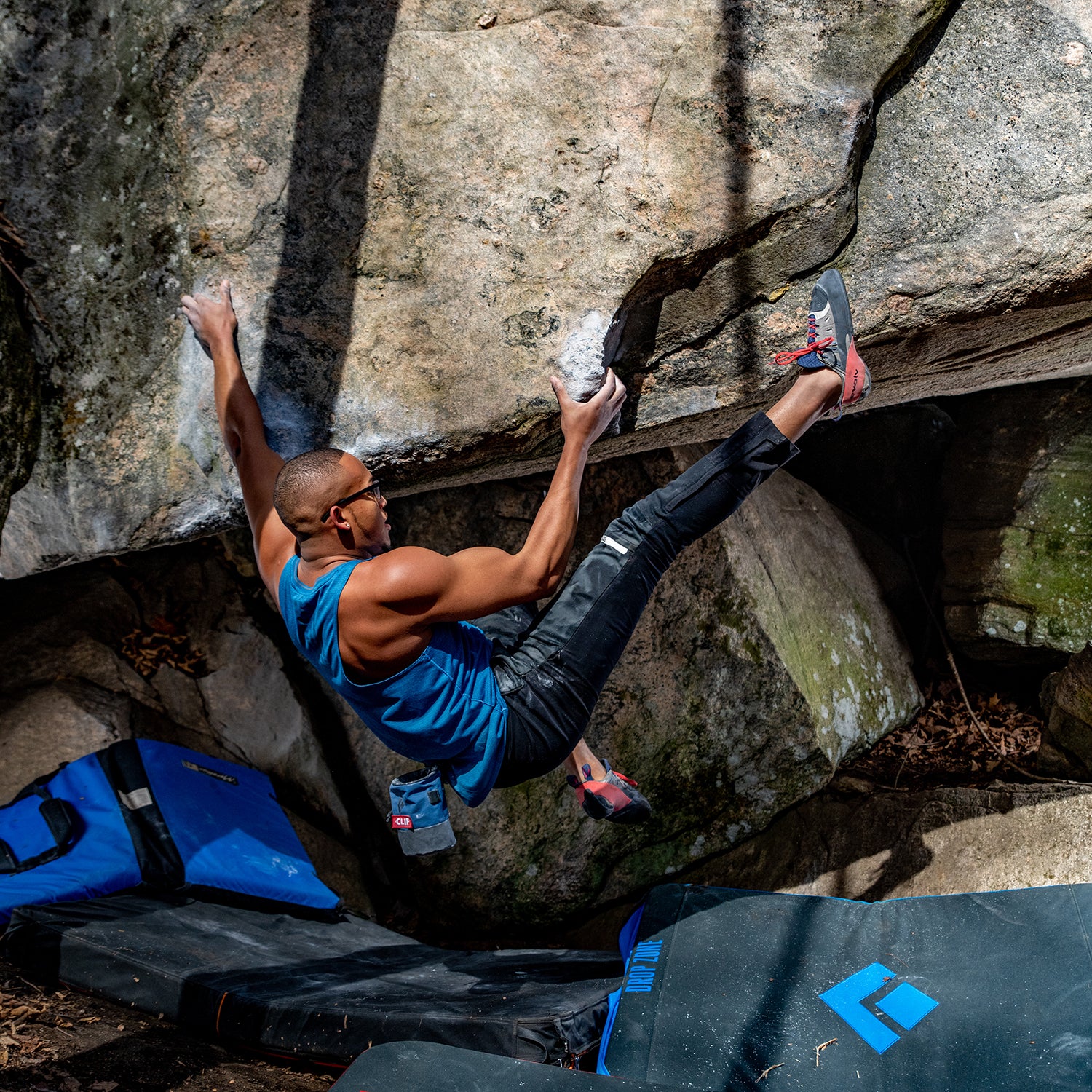In 2016, I attended an American Alpine Club gala with leaders of the outdoor community. One conversation I had there has stuck with me since. A friendly, soft-spoken woman walked up to my mom and me and started talking╠řabout diversity initiatives in rock climbing and outdoor recreation. She was confused about why theyÔÇÖre necessary. ÔÇťThe outdoors is╠řfree and open,ÔÇŁ she insisted. ÔÇťAnyone can choose to go outside and participate in activities. Minorities simply choose not to participate. Why should we pour money into efforts to convince them otherwise?ÔÇŁ A gentleman standing nearby overheard this╠řand decided to join in with his two cents. ÔÇťRock-climbing walls are popping up at recreation centers and Boys and Girls╠řClubs everywhere,ÔÇŁ he said. ÔÇťThere is really no need for additional initiatives. Minorities are getting opportunities to enjoy rock climbing.ÔÇŁ After listening to their comments, my mom and I gave each other a sideways glance and simultaneously took a deep breath. We then proceeded to offer them a lengthy explanation of participation gaps; they didnÔÇÖt find it convincing.
Unfortunately, these sentiments are shared by many people in our community. Following the recent killings╠řof George Floyd, Breonna Taylor, and others, and the ensuing wave of protests, the outdoor industry is reckoning with its huge diversity gapÔÇöand questioning how inclusive the outdoors truly is╠řfor people of color. In response, numerous╠řcompanies have released statements expressing their commitment to increasing diversity, equity, and inclusion (DEI). If companies are serious about accomplishing these goals, itÔÇÖs crucial that they first understand the common reasons that fuel the participation gap so they can tailor initiatives accordingly.╠ř
The first key factor is how comfortable we feel in various outdoor environments. Many people of color are mentally conditioned at a young age to navigate society in specific ways to stay safe. I was six when I first had ÔÇť.ÔÇŁ My best friend, Mason, who was white, lived three houses down, and being kids, instead of walking down the street, we would hop the fences to get to each otherÔÇÖs homes. One day while we were outside playing, my mother called MasonÔÇÖs mom and told me to come home immediately. As I approached the house, I saw my mother sitting on the stairs of our front porch. She tried to smile while leading me inside the house, but I could see that her eyes were red and puffy. SheÔÇÖd received a concerning phone call from a neighbor about me hopping fences, which meant it was time for us to have a discussion I would never forget.
Many people of color are mentally conditioned at a young age to navigate society in specific ways to stay safe.
She started the conversation by telling me how much she loved me, and saying that I needed to trust everything that she was going to tell me, even if I didnÔÇÖt understand. She then proceeded to tell me about various incidents involving young Black kids who had been murdered or incarcerated for reasons I couldnÔÇÖt comprehend. With tears streaming down her face, she pulled out her computer and started showing me news stories of kids that looked just like me. I remember asking whether she was telling me I could not trust white people. ÔÇťNo,ÔÇŁ she said. ÔÇťI am telling you that some people will judge and mistreat you just because of the color of your skin. Most often, you will not know whether the person you are interacting with is a bad person until it is too late. If you want to stay safe, there is a certain way you must always act. If you and your white friends do the same thing, the consequences for you could be much more dire.ÔÇŁ
As a╠řsix-year-old, I was confused; the intensity of the moment was overwhelming. At the time, I didnÔÇÖt understand how simply playing with my friend earlier that day had led to this conversation. During the years that followed, these discussions became more regular. They ultimately prepared me for :╠řDuring a gas-station stop to use the bathroom,╠řIÔÇÖd gazed at the huge candy section as I walked down the aisle, and the store owner met me outside the restroom as I exited. He accused me of stealing and forcibly searched me. Despite being physically violated, I knew to stay calm, not fight back, and run to safety as soon as I could. By the time I was 18, I had become fully adjusted to the idea that my reality would always be different than some of my friends, and maintained a mental checklist of things to remember for my own protection.
These experiences are not unique to me. Most African Americans are exposed to this harsh reality at a similar age, if not younger. Understanding this mindset is key to implementing effective DEI initiatives. If African Americans, for example, are already apprehensive in a society where we make up , it should be understandable that we are hesitant to be a part of a community╠řwhere we represent as little as╠ř. James Edward Mills, author of , put it best: ÔÇťItÔÇÖs not enough to say that the outdoors is free and open for everyone to enjoy. Of course it is! But after four centuries of racial oppression and discrimination that systematically made Black Americans fear for their physical safety, we must also make sure that we create a natural environment where people of color can not only feel welcome but encouraged to become active participants as outdoor enthusiasts and stewards dedicated to the protection of the land.ÔÇŁ╠ř
Any outdoor diversity and inclusion initiative must include coordinated efforts to help minorities feel welcome and safe venturing outdoors. This starts with educating outdoor-industry workers through DEI training, so they can better facilitate inclusive spaces for minorities in their companies and communities. We also need initiatives promoting this education for individual participants. In rock climbing, many╠řpopular crags are located in remote╠řareas╠řwith regressive ideas about race. It is not uncommon for people in these communities to proudly display racist symbols on homes, businesses, and cars. Racism can even be found in guidebooks, as numerous climbs have names with racial undertones and racist slurs. If these communities make us feel marginalized, weÔÇÖre╠řnot likely to return.
Despite being painfully aware of racial issues that could arise in a space that is almost entirely white, I never feared the sport of rock climbing. I attribute this to my mother always being nearby, helping me handle uncomfortable situations. My mom grew up in an inner-city, poverty-stricken community before earning a Ph.D.╠řin applied mathematics. Her experience navigating such different environments made me comfortable trusting her instincts and her ability to keep me safe. However, this is an exception; many kids of color╠řare not as fortunate to have a parent who is willing and able to follow them around the world, investing in their passion for an obscure sport that doesnÔÇÖt offer a╠řhigh-paying career path.
This brings me to the second significant component of the participation gap: cost. Minority communities are often located in inner cities,╠řfar from national parks and other public lands, and╠řthe price of gym passes, equipment, transportation to gyms, and mentorship programs are all╠řtypically steep. Companies can help by sponsoring initiatives to mitigate these expenses. This might╠řinclude offering day passes at a reduced price for low-income individuals, or sponsoring DEI programs after school or during the summer to get more young people of color╠řinvolved.
╠řis one example of an organization that has integrated DEI into its╠řbusiness model. Located in a predominantly minority, low-income part of╠řMemphis, Tennessee, this nonprofit climbing gym operates as a pillar for its╠řcommunity. Since it opened╠řin 2018, it has╠řprovided daily initiatives like free meals, after-school programs, and mentorship for local kids. Memphis Rox also offers a pay-what-you-can cost structure that╠řallows participants to offset normal gym fees with volunteer hours at the gym╠řor a local charity. It╠řhas introduced almost 200,000 people to the sport╠řand continues to cater to the╠řcommunityÔÇÖs needs during this tumultuous time. For example, it╠řrecently implemented╠řa clothing closet, where people could donate items to assist families affected by the pandemic. Businesses like Memphis Rox are a model for effectively increasing diversity in rock climbing.
Unfortunately, these╠řorganizations struggle to cultivate╠řthe consistent funding and corporate connections to sustain their programs. In╠řtalking with my sponsors and different organizations about their plans for DEI initiatives, I found that╠řmany of them wanted╠řto╠řfacilitate the╠řlong-term changes society has been╠řdemandingÔÇöbut they didnÔÇÖt know how. One thing is╠řclear: one-time donations are not going to cut it. A sustainable model has╠řto be created that will╠řestablish long-lasting relationships╠řbetween corporate businesses, grassroots DEI organizations, and community leaders seeking change in their neighborhoods. Following╠řthese conversations, in late July I decided to create a nonprofit called , which aims to connect underserved communities with organizations eager╠řto provide opportunities and diversify the outdoors.╠ř
The recent media coverage of the unjust killings of Black people has brought to light many systemic issues that minorities face within the outdoor industry and in our greater society. While we welcome the countless statements made by companies promising to combat systemic racism, there is still a lot of apprehension from people of color. We have seen statements of solidarity come and go with minimal follow-through. For diversity initiatives in the outdoor industry to be effective, we need sustainable╠řsolutions that will provide more access and gain the trust and support of minority communities. This requires the collective efforts of both companies and individuals within the outdoor industry to address the political, social, and socioeconomic factors that make the outdoors inaccessible for many. If we want the landscape of our community to mirror the diversity in our society, we have tremendous work to do to ensure inclusive spaces for us all.


